Product Review: Lake Country Force Pads
by Ivan RajicI have been using Lake Country pads for as long as I can remember. Sure I have a few random Meguiar’s, Scholl and Rupes pads, but 95% of the pads we use are Lake Country and they are used 99% of the time :). Sometime last year DI switched to smaller profile pads (.875″) and I wasn’t a huge fan. We were used to the thicker (1.25″) pads that were 5.5″ in diameter and the thinner ones weren’t working well for us with the Flex 3401. I was very fortunate that Lake Country manufactured a few of the old pads (same thickness, but slightly better backing design) for us and that’s what we’ve been using for quite some time now.
Recently I got a chance to try out these new Lake Country Force Pads and I’m very impressed. All of us at the shop really liked working with them the moment we tried it. As I said, 99% of the time we’re using a Flex 3401 polisher and these were a great fit.
As always, they come in a variety of colors, thus variety of cutting and finishing options.

The new grey pad is very hard and great for cutting, although I haven’t used that one as much as the others. The white and orange pads are ones we use most of the time in the shop and the new pads definitely performed well. I’m not sure if it was just because it’s a cool new pads, but all three of us at the shop liked the new pads more than the old. They seemed to work really well, easy to control and performed their duty perfectly. I was initially wondering why the center had a hole and we figured it was either for cooling or centering, both of which are true. I’m assuming they’re a bit easier to use due to the hole as polish doesn’t collect at the center and there’s less foam on the surface. Even so, the correction doesn’t suffer at all.
The other great thing is the new shape…
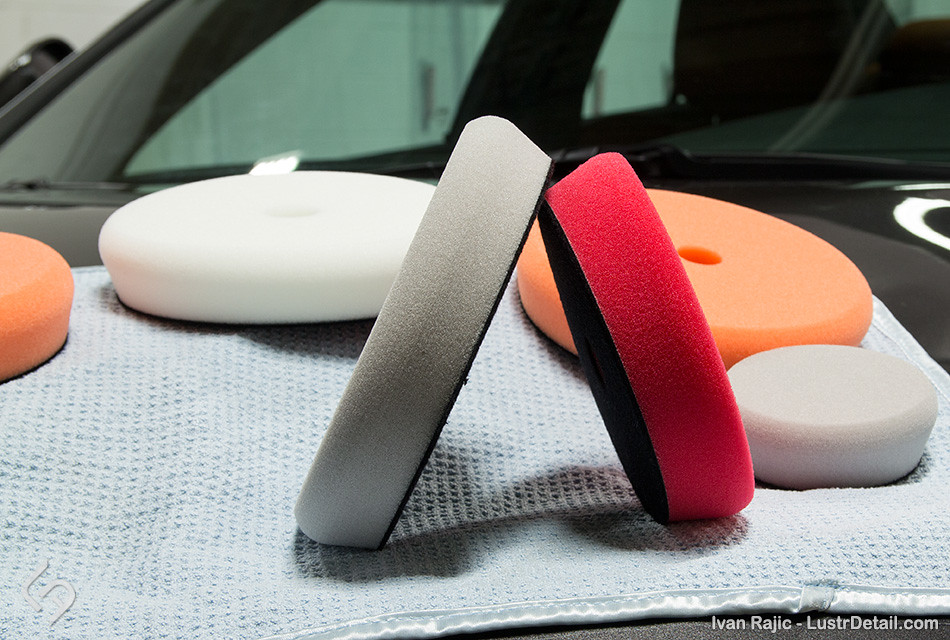
As cliche as it may sound, the rounded design is both safe and effective. It’s safe in that the backing hook and loop or the backing plate are far enough from the edge of the foam to not cause any damage when working on tight corners. It’s effective because you can apply very even pressure that gets distributed equally due to the angled edges. I failed to get a photo of this, but when it’s compressed a bit the edge actually becomes sharper, allowing you to polish tight corners effectively.
The backing of the pad goes all the way to the edge of the foam. This works well when centering the pad and also makes removal safer since you’re not pulling the backing from the actual foam, possibly delaminating and ruining the pad…
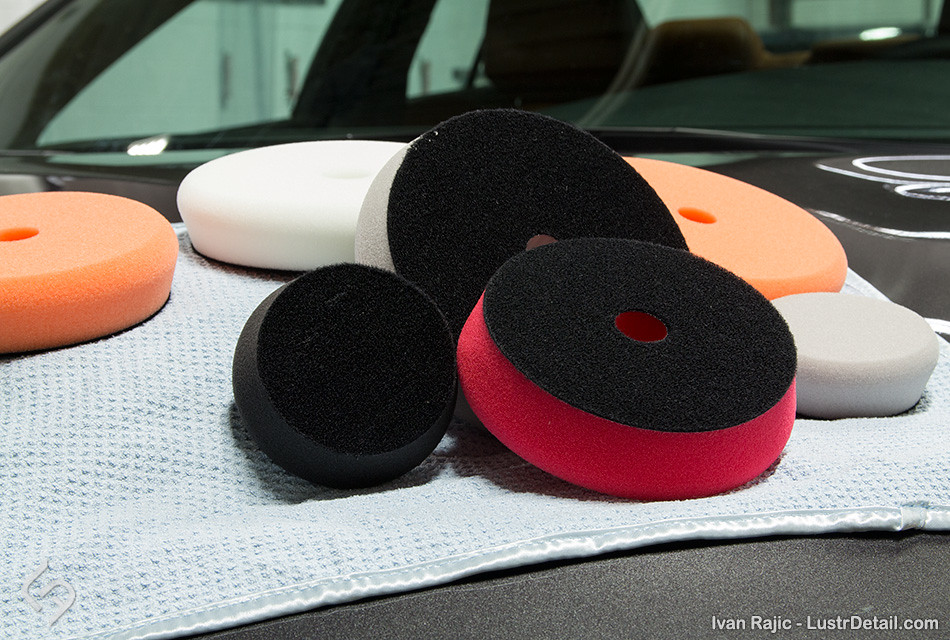
The regular Flex 3401 backing plate fits great on the larger 6.5″ pad and our modified backing plate is a perfect fit for the new 5.5″ pads. As you may have read in one of my previous articles, at my shop we almost exclusively use 5.5″ pads, so we had to modify the Flex 3401 backing plate to fit. It’s simply trimmed to be slightly less in diameter than the actual pad backing…
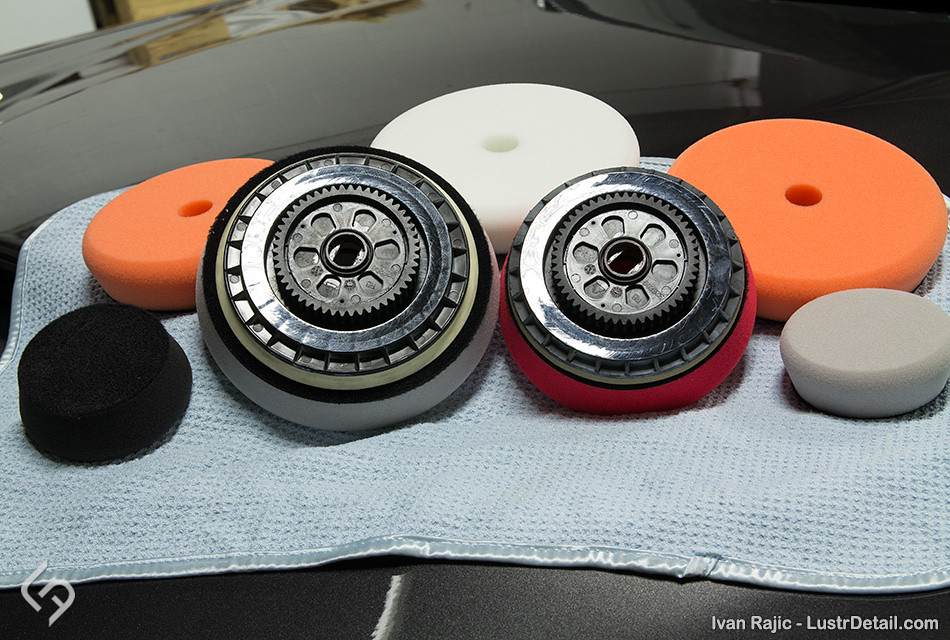
The various sizes are obviously great as there are many different parts of a car where a different sized pad is more effective and efficient. We have been using the 6.5″ pads on flatter surfaces like hoods, doors, trunks and roofs. The 5.5″ pads still remain our favorite and are used on just about anything. Finally, the 3″ pads are great for license plate areas, door pillars and some tight bumpers…
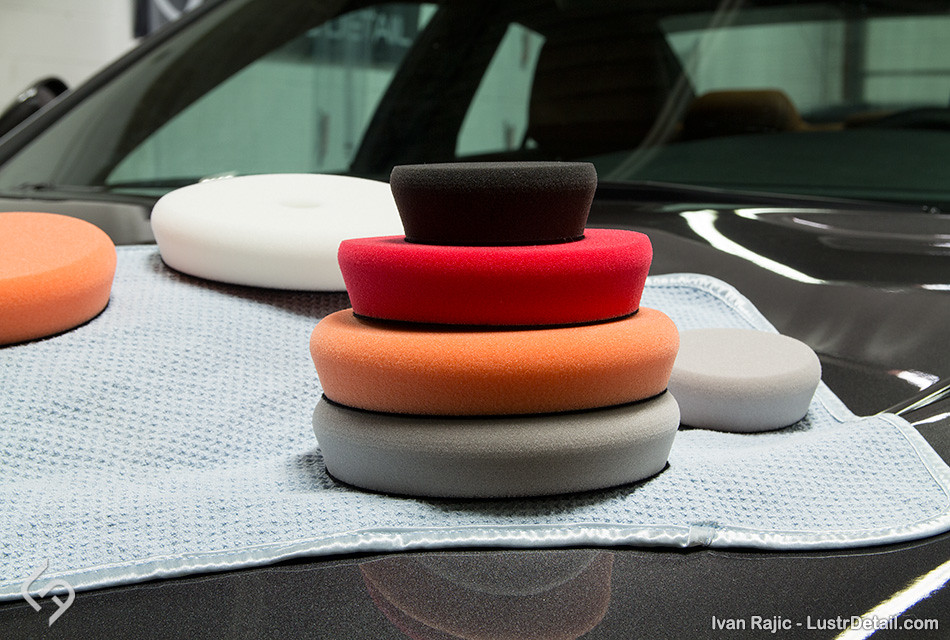
Here’s a shot of one of the orange 5.5″ pads on our very much so used and abused Flex 3401. A little ad within this review for the Flex 3401… These polishers are just about invincible. I’ve owned 4 (still do) and after 3-4+ years of heavy use and all these machines require is a regular brush change and blowing out the inside. Oiling the inside of the housing under the pad is a great idea of course, but one of the machines has proven it doesn’t require it :). Only one I destroyed by not switching the brushes for a long time and the armature went bad, but for $120 I will have it working like new.
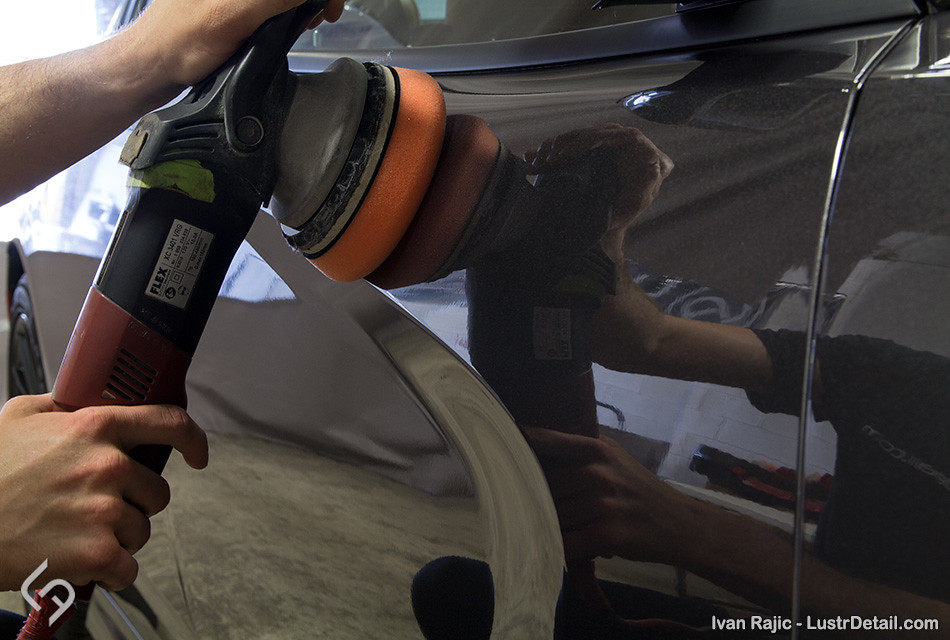
Back on topic! The new LC Force Pads are great and I highly recommend it, that’s about all I wanted to say initially. We’ll slowly be replacing a lot of our older used pads with these as everyone at the shop likes them a lot. They’re the typical Lake Country quality and performance, but with added features that take them to the next level. I’ll be ordering quite a few more soon and I can’t wait to hear what others have to say.











I’m also a huge fan of the 3401, bp of 4″ and hybrid pads.
I always wanted a hybrid pad that would cut more than the orange, and finally they made it.
Also, the center hole makes it compatible with the Rupes BigFoot.
I can’t wait to lay my hands on it. Yes!
Thank you for the review! I also pretty much use the Flex 3401 on all my jobs and its a great tool. Really looking forward to trying these new pads.
Nice Ivan… here’s hoping the Force is strong with all of us!!
How do these new pads behave when used on the PE14?
I haven’t tried it on the PE14 yet, so maybe someone else can chime in.
It’s good to hear someone still uses the Flex 3401. I am a proud owner of two. One is getting serviced for new brushes.
Were the Force pads designed for the Flex or the Rupes? The Flex seems to be the odd duck out with all the Chinese copycat polishers trying to make a Rupes polisher. Even Flex has jumped into the fray with their own copy of the Rupes 15. I love the hole in the middle of the pad it makes it so much easier to center the pad and keeps the pad cooler depending on the polisher backing plate. Rupes should have patented this innovation too (not sure they were the first though). Thanks for the write up and happy detailing!
One last question. How do you use the 3 inch pad on the Flex 3401? Do you use the Flex rotary polisher? Thanks.
Robert, the pads were designed for the Flex 3401 and/or rotary machines according to Lake Country. The thicker material helps in this case and I agree. You should not use the 3 inch pads with the 3401 as it’s too small. Use these with either a rotary or a random orbital with smaller backing plates, such as the Porter Cable or Griots.
Ivan, do these new pads (with the hole in the middle) require a new backing plate? Or can you use a traditional backing plate? I use a Porter Cable….
They’re the normal velcro backing pads, so used with standard/traditional backing plates.
When is Flex going to make a backing plate that works with the 5.5 inch pads?? I ruined one of my backing plates trying to modify it.
I hope VERY soon. They do have the 4.375″ backing plate (https://www.detailedimage.com/Flex-M26/XC-3401-VRG-Backing-Plate-P175/4-S2/) that can be used with 5.5″ pads, but it’s a bit too small in my opinion and a 4.75-5″ size would be much better.
All these years later and STILL no 5 inch backing plate for the Flex 3401. Does anybody sell these?
John – Flex manufacturers a 5.5″ and 4.375″ at this time. Depending on the size of the back of the pads you are using, each of these backing plates will work great.
I don’t like the hole because I feel like debris could get stuck in there and work it’s way out at a later time. Or a tiny bit of metal or etc. could come off from around the screw area. And if you press hard enough, wouldn’t the metal screw in the center be touching the paint? The whole “hole” thing give me the heebie-jeebies.
What screw are you talking about Jason? The screw on the Flex 3401 (along with any other polisher with an exposed screw from my experience) is recessed into the backing plate, so there’s no way the screw can touch the paint even without a pad on there. I really wouldn’t worry about it in this sense.
As for the debris getting stuck, I understand your concern but all it takes to avoid that is a quick pad cleaning, which should be done anyway. The hole serves quite the opposite purpose in my opinion. If some debris was stuck on the pad, I’d prefer for it to be in the hole rather than right on the foam with the only way to go being into the paint. As for the specific debris coming from the screw area, yes that’s definitely a valid point and the only thing you can do is make sure the screw area is very clean before putting the pad on there. I try to replace the screw and washer for the backing plate every now and then so it doesn’t form rust, but in general I haven’t had any issues with debris coming from there on any of our 4 3401 polishers.
The New LC Force pads are awesome, love the thickness and rounded edges!!! The 3″ are especially great and my favorite for griot’s 3 inch polisher. Also, the force pads are great with the Flex 3401!!!
Ivan, you mentioned “modified backing plate is a perfect fit for the new 5.5″ pads”, where can I find the article on making this modification?
Thanks
David
There’s no article as far as I know David, but I may write one soon.
Between Country CCS Yellow Cutting Pad & Lake Country Force Grey Force Heavy Cutting Pad which Pad is More Aggressive and Cuts More……
Does any make and sale good orbital bonnets 10″ that are better than what I can find at my local auto stores or Walmart? What I see here are only pads for electric buffers and really none for orbital buffers, I sure could use some good ones.
I never really use those Art so I’m not sure.
Ok, I am not to sure about using the other type of buffer. Some friends say I could harm the paint if I don’t know how to us it.
I may purchase one and work on an old car to see how well I can do.
Just starting out to see if I want to do this as a mom and pop detail shop.
Thanks
You gave 0 insight on how this pad differentiates from the others and what incentives lie behind switching over to it. Kudos!
I’m not sure if you read the whole article Kevin, but I touched on quite a few things (hole in the pad, shape of the edges and backing of the pad). Aside from a quick comparison to the old Lake Country pads, I didn’t compare them to other foam pads on the market because there are hundreds and would make for a very long article. If you do have specific questions feel free to post and I’m sure someone will be able to help you out. Hope that helps.
I too, would like to know how you trim down a backing plate to fit the 5.5” pads.
You would think LC would have already addressed this situation.
Thanks
We have a couple different techniques but for the sake of safety I don’t want to be giving instructions on here :). It includes a blade, common sense, dremel and rotary polisher (in that order). Joking aside, in a bind I just cut it down with a small box cutter, but when we have time we refine them with a dremel tool so there’s no sharp edge etc.
why or what is the reason behind pads larger than the backing plates and not the same size? been hearing all kind of stories about but i`d like to hear you say and the reason behind it, to me its a pain in
the butt to not have the right size pad to the backing plate, but thats just me, some my like it and i dont
Mark – In general, you do not want your pad to be the same size or slightly smaller than the backing plate, as that will expose the edges of the backing plate. This greatly increases risk of the backing plate hitting the edge of the paint while polishing.
With flat foam pads, most are slightly larger than the backing plate, for example 5.5″ pad for a 5″ backing plate. For pads like the Force pads, they are beveled, so a 5″ back will carry a 6″ front. Each is designed to cover the edges of the backing plate for safe polishing!
Wow, ok that’s a new for me, but I guess when you use orbital 99 to 100 percent I can see, I’m more into rotory old school I guess, and use the orbital to find tune, but thanks for info at least now I know the reason why, much appreciated